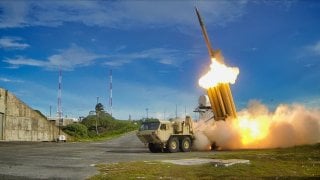THAAD: America's Very Best Missile Killer in Asia?
THAAD is a highly effective, combat-proven defensive system that is designed to shoot down short, medium, and intermediate-range ballistic missiles in their terminal phase—descent or reentry—by intercepting with a hit-to-kill approach.
The United States Indo-Pacific Command (INDOPACOM) announced the successful Table VIII evaluation of its state-of-the-art Terminal High Altitude Area Defense (THAAD) system in Guam earlier this month. The test was conducted by Task Force Talon’s ADA THAAD Battery, which is tasked with defending Guam and its surrounding areas against potential ballistic missile threats. Amid evolving security challenges in the region, completing the Table VIII evaluation highlights the unit’s preparedness to effectively deter and counter emerging threats. The evaluation showcased the unit’s proficiency in missile defense operations, underscored its critical role in bolstering regional security in the Pacific, and further demonstrated the unit’s proficiency in missile defense operations and critical role in bolstering regional security.
“Table VIII is the first assessment in the series of gunnery tables that brings in external evaluators to assess the Battery’s proficiency on their gunnery task as a collective,” explained Chief Warrant Officer 4 Jennifer Burns, the lead evaluator.
According to INDOPACOM, the soldiers underwent rigorous training scenarios designed to test their ability to deploy, operate, and maintain the THAAD system under simulated combat conditions. From rapid deployment drills to simulated missile engagements, the evaluation encompassed a range of tasks to assess the unit’s combat readiness and proficiency.
What About THAAD
THAAD is a highly effective, combat-proven defensive system that is designed to shoot down short, medium, and intermediate-range ballistic missiles in their terminal phase—descent or reentry—by intercepting with a hit-to-kill approach.
It is a relatively recent addition to the United States military’s anti-ballistic missile/interceptor systems, though the concept was first proposed in 1987, while a formal request for proposals was submitted to industries in 1991 following experiences from Iraq’s Scud missile attacks during the Gulf War.
In September 1992, the U.S. Army selected Martin Marietta (now part of Lockheed Martin) as the prime contractor for THAAD development. It remains the only U.S. system designed to intercept targets outside and inside the atmosphere. THAAD continues to have incremental capability improvements within the weapon system to improve its effectiveness against current and emerging threats. It occupies a middle tier in the United States military’s Ballistic Missile Defense System (BMDS) and can cover a larger defended area than the Patriot missile system while serving as an underlay for the exoatmospheric Aegis ballistic missile defense and ground-based midcourse defense systems.
The THAAD interceptor is noteworthy for not carrying a warhead; instead, it relies on the kinetic energy from the impact to destroy incoming missiles. The kinetic energy is meant to minimize the risk of exploding a ballistic missile’s conventional or nuclear-tipped warhead. The system was further designed to be highly mobile, consisting of four main components including a truck-mounted launcher, eight interceptors on the launcher, a transportable radar system, and a fire control system that links the various components with external command centers.
Take THAAD
THAAD operates much like other missile interceptors and surface-to-air missile systems. According to Lockheed Martin, there are four stages to its operation beginning with the THAAD systems’ activation when an X-Band active electronically scanned array (AESA) radar (AN/TPY-2) detects and identifies a target projectile. THAAD’s fire control and support equipment then identifies and verifies the threat before initiating the launcher.
The launcher then releases the infrared seeker head-equipped THAAD missile, and in theory, THAAD destroys the incoming missile by colliding with it in the fourth and final stage.
However, THAAD’s development was protracted following several early failures, which resulted in a redesign that included a more powerful thrust vector control and divert systems, improved computers, and simplified avionics.
THAAD Deployment
The anti-missile system has been deployed to U.S. facilities around the world, including in Israel, South Korea, and Turkey.
Last October, U.S. Central Command (CENTCOM) deployed a THAAD anti-ballistic missile battery along with additional Patriot missile battalions to undisclosed locations in the eastern Mediterranean in response to “recent escalations” on the part of Iran and its proxies over the war between Israel and Hamas.
There are currently seven THAAD systems operated by the U.S. Army, according to Lockheed Martin.
Author Experience and Expertise: Peter Suciu
Peter Suciu is a Michigan-based writer. He has contributed to more than four dozen magazines, newspapers, and websites with over 3,200 published pieces over a twenty-year career in journalism. He regularly writes about military hardware, firearms history, cybersecurity, politics, and international affairs. Peter is also a Contributing Writer for Forbes and Clearance Jobs. You can follow him on Twitter: @PeterSuciu.
You can email the author: [email protected].


